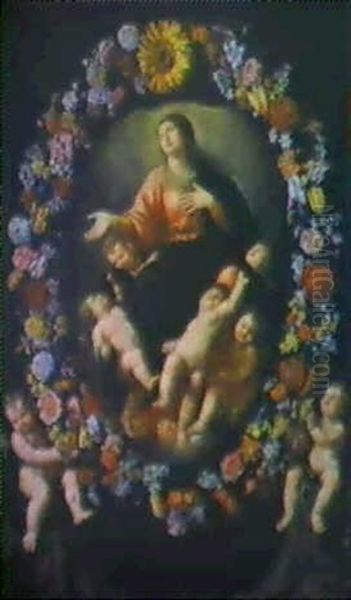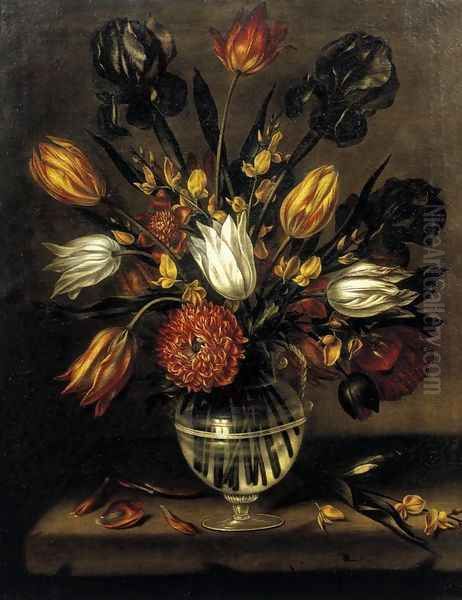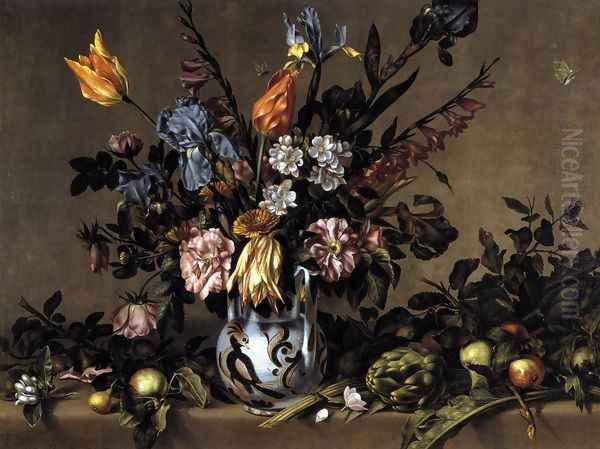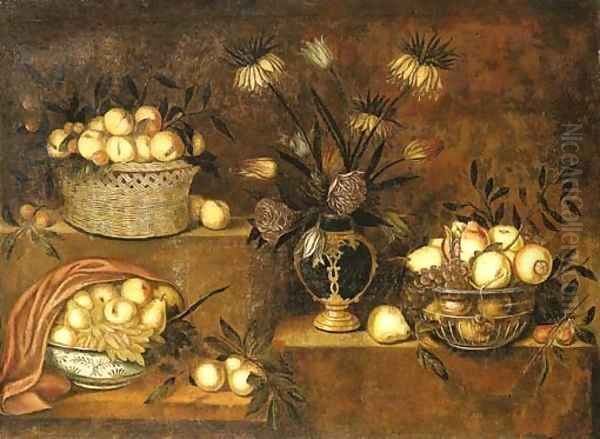Antonio Ponce (1608-1677) stands as a notable, if sometimes overlooked, figure in the rich tapestry of Spanish Baroque art. Active primarily in Madrid during a golden age of Spanish painting, Ponce carved a niche for himself as a specialist in still life and flower painting, genres that flourished with unique character on the Iberian Peninsula. His career, spanning roughly from 1634 to 1662, saw him navigate the artistic currents of his time, learning from established masters and developing a personal style that contributed to the enduring legacy of Spanish bodegones (still lifes) and floral compositions.
Early Life and Artistic Formation in Madrid
Born in Valladolid in 1608, Antonio Ponce's formative years and artistic development took place in Madrid, the vibrant political and cultural heart of Spain. The city was a crucible of artistic talent, home to luminaries such as Diego Velázquez, Francisco de Zurbarán, and Alonso Cano, creating an environment ripe with opportunity and influence for aspiring painters. Ponce's formal artistic training commenced significantly when, around the age of sixteen, following the death of his mother, he was apprenticed to Juan van der Hamen y León (1596-1631).
Van der Hamen was a pivotal figure in the establishment and popularization of still life painting in early 17th-century Spain. Of Flemish descent, he brought a Northern European precision and sensibility to his work, which he masterfully adapted to Spanish tastes. His compositions were celebrated for their clarity, meticulous detail, and sophisticated arrangements of food, flowers, and tableware. For the young Ponce, this apprenticeship was a profound immersion into the techniques and aesthetics of still life. He would have learned the fundamentals of oil painting, the careful observation of objects, the rendering of textures, and the principles of composition that characterized his master's style.

The connection to Van der Hamen's circle was further solidified in 1628 when Antonio Ponce married Francisca de Alfaro, who was Juan van der Hamen y León's niece. This union not only integrated Ponce into a prominent artistic family but also likely provided him with continued access to Van der Hamen's studio practices, clientele, and artistic network, even after the master's untimely death in 1631. This familial and professional bond undoubtedly shaped the early phase of Ponce's independent career.
The Evolution of an Artistic Style
Antonio Ponce's early works, as might be expected, bear the strong imprint of his master, Juan van der Hamen. These pieces often feature carefully arranged objects against dark, neutral backgrounds, with a focus on symmetry and a somewhat formal, structured composition. The lighting tends to be direct, highlighting the textures and forms of the individual elements. This adherence to Van der Hamen's model is evident in the clarity and precision with which he rendered fruits, flowers, and vessels.
However, as Ponce matured as an artist, he began to develop a more personal style. While the influence of Van der Hamen remained a foundational element, Ponce's later works exhibit a subtle shift. There is often a softening of the light, creating more nuanced interplay of light and shadow (chiaroscuro), which lends a greater sense of atmosphere to his paintings. His compositions, too, began to show more freedom and a less rigid adherence to symmetry. He explored more dynamic arrangements, allowing for a greater sense of naturalism and spontaneity, particularly in his floral pieces.
Ponce demonstrated a keen ability to capture the varied textures of his subjects – the delicate petals of flowers, the sheen of ceramic or glass, the rough skin of fruits, and the crispness of biscuits. His palette, while often grounded in the earthy tones characteristic of Spanish Baroque painting, could also be enlivened by the vibrant hues of the flowers and fruits he depicted. This evolution suggests an artist who, while respectful of his training, was also responsive to other artistic trends and confident in exploring his own sensibilities. He was a contemporary of other still life painters like Juan de Espinosa and Antonio de Pereda, who also contributed to the genre's diversity.
Key Themes and Genres: Bodegones and Floral Masterpieces
Antonio Ponce's oeuvre is primarily concentrated in two interconnected genres: the still life (bodegón) and flower painting.
Spanish Bodegones:

The Spanish bodegón of the 17th century was distinct from its counterparts in other parts of Europe. While Flemish still lifes often celebrated abundance and opulence, Spanish examples tended towards a more austere and contemplative realism. They often featured humble, everyday objects and foodstuffs, arranged with a sense of dignity and quiet presence. Ponce's still lifes, particularly those featuring fruits, sweets, and tableware, align with this tradition. Works like his Basket of Fruits showcase his ability to render these items with tactile realism, inviting the viewer to appreciate their simple beauty and material qualities. These paintings often carry an implicit vanitas theme, a reminder of the transience of earthly pleasures and the passage of time, though usually more subtly than in the overtly symbolic works of artists like Juan de Valdés Leal.
Flower Paintings:
Flower painting as a distinct genre gained prominence in Europe during the 17th century, with Flemish artists like Jan Brueghel the Elder and Daniel Seghers leading the way. In Spain, this interest also took root, and Ponce became one of its notable practitioners. His floral compositions, such as the renowned Vase of Flowers (1650), demonstrate his skill in capturing the delicate beauty and variety of different blooms. These paintings were not merely decorative; flowers often carried symbolic meanings related to purity, love, the Virgin Mary, or the fleeting nature of life. Ponce's arrangements are typically lush and vibrant, showcasing a variety of species with botanical accuracy, yet composed with an artistic eye for balance and harmony.
Guirnaldas (Garlands):
A particularly interesting subgenre in which Ponce excelled was the guirnalda, or flower garland painting. These compositions typically feature an elaborate wreath of flowers, fruits, or both, surrounding a central image, which could be a religious scene, a portrait, or an allegorical figure. This format was popularized by Flemish artists like Daniel Seghers, who often collaborated with figure painters. Ponce adopted this format, and it is in these works that his collaborations with other artists become evident. The central figurative elements in his guirnaldas were sometimes painted by specialists in that area, allowing Ponce to focus on his forte: the intricate and beautifully rendered floral elements.
Notable Works and Their Significance
Several key works help to define Antonio Ponce's artistic contribution:
Vase of Flowers (1650): This painting is a quintessential example of Ponce's mature floral style. It typically depicts a profusion of different flower species – roses, tulips, irises, carnations – artfully arranged in a decorative vase. The work showcases his meticulous attention to detail in rendering the petals and leaves, his understanding of light as it falls across the varied surfaces, and his ability to create a harmonious, if dense, composition. Some critics have noted a certain "dryness" or lack of "airiness" in comparison to the more atmospheric works of some Flemish masters, but the painting's strength lies in its decorative impact and precise execution.

Basket of Fruits: While specific, universally recognized paintings with this exact title might vary in attribution or current location, Ponce is known to have painted numerous compositions featuring baskets laden with fruits. These works highlight his skill in depicting the textures and colors of various fruits like grapes, pomegranates, apples, and pears, often accompanied by other elements like ceramic bowls or boxes of sweets. They exemplify the Spanish bodegón tradition of presenting everyday items with a sense of sober dignity.
Guirnalda de flores con Asunción de la Virgen (Flower Garland with the Assumption of the Virgin): This work, likely a collaborative effort, is a prime example of the guirnalda genre. Ponce would have been responsible for the lush, intricate garland of flowers framing a central scene depicting the Assumption of the Virgin Mary, painted by a figure specialist. Such paintings were popular for devotional purposes and demonstrate the integration of still life elements into religious art. The flowers themselves would carry symbolic weight, enhancing the sacred theme. The opulence of the garland combined with the religious scene aligns well with the dramatic and emotive tendencies of Baroque art.
Guirnalda de flores con alegoría del Amor divino (Flower Garland with Allegory of Divine Love): Similar in format to the Assumption garland, this piece would feature a central allegorical representation of Divine Love, encircled by Ponce's expertly painted flowers. The choice of flowers and their arrangement would likely contribute to the allegorical message, exploring themes of spiritual love, purity, and divine grace. Such works highlight the intellectual and symbolic depth that could be embedded within seemingly decorative floral paintings.
Crystal Vase (1644): A signed and dated work, once in private collection and exhibited at Rafael Valls Limited in London, this piece would showcase Ponce's ability to render reflective and transparent surfaces, a true test of a still life painter's skill. The interplay of light on crystal, combined with the flowers it contained, would create a dazzling visual effect.
These works, and others attributed to him, demonstrate Ponce's dedication to the still life and floral genres, his technical proficiency, and his ability to imbue his subjects with both visual appeal and, at times, deeper symbolic meaning.
Collaborations and Artistic Contemporaries
The artistic environment of 17th-century Madrid was characterized by both competition and collaboration. Antonio Ponce, like many artists of his time, engaged in collaborative projects, particularly for complex compositions like the guirnaldas.

His most significant early influence and connection was, of course, Juan van der Hamen y León. Beyond this foundational relationship, Ponce is known to have collaborated with Francisco Barrera (c. 1595–1658), another prominent still life painter active in Madrid. Barrera was known for his market scenes and series of paintings representing the seasons, often incorporating abundant displays of fruits and vegetables. Their collaboration likely involved projects where their complementary skills could be combined, perhaps on larger decorative schemes or series of paintings.
For his guirnalda paintings, Ponce collaborated with figure painters. Juan de Arellano (1614–1676), a younger contemporary who would become one of Spain's most celebrated flower painters, is documented as having collaborated with Ponce on such works. While Arellano himself was a master of floral depiction, collaborations could involve one artist painting the figures and the other the surrounding garland, or they might have worked jointly on different sections of large commissions. The information also suggests a collaborator named "Pablo Mole" . This collaboration would have also centered on the guirnalda format, with "Mole" presumably handling the central figurative scenes.
Beyond these direct collaborators, Ponce worked within a vibrant community of artists in Madrid. The towering figures of Diego Velázquez (1599–1660), court painter to Philip IV, and Francisco de Zurbarán (1598–1664), renowned for his powerful religious paintings and striking still lifes, set a high bar for artistic excellence. While Ponce specialized in a different domain, he would have been aware of their innovations and the prevailing artistic tastes they helped to shape.
Other still life specialists active during or overlapping with Ponce's career include Juan de Espinosa (active c. 1619–1659), known for his meticulously detailed depictions of grapes, and Antonio de Pereda (1611–1678), famous for his allegorical vanitas still lifes and religious paintings. Bartolomé Pérez de la Dehesa (1634–1698), a student of Van der Hamen and later son-in-law to Juan de Arellano, continued the tradition of flower painting into the latter half of the century. Further afield, the influence of Flemish masters like Jan Brueghel the Elder (1568–1625) and Daniel Seghers (1590–1661) on the development of flower painting was pervasive throughout Europe, including Spain. Even earlier Flemish pioneers of still life like Clara Peeters (1594–c. 1657) and Osias Beert (c. 1580–1623) had helped lay the groundwork for the genre. Ponce's work, therefore, is best understood within this broader context of Spanish and European still life traditions.
Symbolism and Meaning in Ponce's Art
While many of Antonio Ponce's still lifes and flower paintings can be appreciated for their sheer aesthetic beauty and technical skill, they often carry layers of symbolic meaning, typical of Baroque art.

In the context of religious works like the Guirnalda de flores con Asunción de la Virgen or the Guirnalda de flores con alegoría del Amor divino, the flowers themselves are imbued with symbolism. Roses, for instance, could symbolize love, martyrdom, or the Virgin Mary (the "rose without thorns"). Lilies often represented purity, while tulips, then a relatively new and exotic flower, could signify wealth or, in a vanitas context, the fleeting nature of beauty and fortune. The careful selection and arrangement of flowers in these garlands were not arbitrary but contributed to the overall devotional or allegorical message of the central scene. The garland itself, an ancient symbol of honor and victory, takes on a spiritual dimension in these contexts.
Even in secular still lifes, symbolic undertones were common. The depiction of fruits and flowers, beautiful but perishable, served as a memento mori – a reminder of the transience of life and the inevitability of death. This vanitas theme was a prominent preoccupation of the Baroque era, reflecting a society deeply engaged with religious and philosophical questions about life, death, and salvation. The presence of insects, wilting petals, or overripe fruit in some still lifes could further emphasize this theme of decay and the passage of time.
The provided information also hints at potential political or social metaphors in his work, suggesting that, like literature, art could critique societal structures or reflect on power and inequality. While direct, overt political commentary might be difficult to pinpoint without specific iconographic analysis of individual works, it's plausible that certain arrangements or choices of objects could carry subtle social connotations for a contemporary audience. For example, the depiction of luxury items versus humble fare, or the juxtaposition of natural beauty with man-made objects, could invite reflection on societal values. However, such interpretations often require deep contextual knowledge of the period's specific social and political climate. The primary symbolic language in Ponce's known works tends to revolve around established religious and vanitas conventions.
Antonio Ponce's Position and Evaluation in Spanish Baroque Art
Antonio Ponce's place in the history of Spanish Baroque art is that of a skilled and dedicated specialist within the flourishing Madrid school of still life painting. His evaluation, however, has sometimes been mixed.
On one hand, he is recognized for his technical proficiency, his beautiful rendering of textures, and his contribution to the bodegón and floral genres. His works, particularly the guirnaldas, demonstrate a capacity for complex and aesthetically pleasing compositions. He successfully absorbed the lessons of his master, Juan van der Hamen, and played a role in perpetuating and evolving this tradition. His paintings found a market, as evidenced by their presence in collections and his collaborative projects.
On the other hand, some art historians have viewed Ponce as being somewhat derivative, particularly in his early career, and perhaps lacking the profound originality or innovative spark of the very top-tier masters of his era. Criticisms occasionally point to a certain "dryness" or a less sophisticated handling of space and atmosphere compared to, for example, Van der Hamen himself or later masters like Luis Egidio Meléndez. His Vase of Flowers, for instance, while detailed, has been described by some as lacking the "airiness" or subtle atmospheric effects found in the works of some of his contemporaries or Flemish counterparts.
It's also important to consider the reception of the Baroque style itself. While today we appreciate its dynamism, emotional intensity, and decorative richness, some contemporary and later neoclassical critics viewed certain aspects of Baroque art as "excessive," "absurd," or in "bad taste," particularly its more ornate manifestations. Ponce's lush floral arrangements, while appealing to Baroque sensibilities, might have fallen under such criticism from those favoring a more restrained aesthetic.
Ultimately, Antonio Ponce should be appreciated as a significant contributor to a specific and important facet of Spanish art. He was not a revolutionary figure like Velázquez, nor did he achieve the widespread fame of Zurbarán in his primary genre. However, within the specialized world of still life and flower painting in 17th-century Madrid, he was a respected and productive artist whose works reflect the aesthetic values and symbolic concerns of his time. He helped to solidify the traditions established by Van der Hamen and contributed to the rich visual culture of Spain's Siglo de Oro.
Later Life and Enduring Legacy
Details about Antonio Ponce's later life are somewhat scarce, a common situation for artists not in the absolute highest echelons of courtly patronage. The provided information mentions a period of difficulty during a "Bonifacio uprising," leading to a police raid on his house and a brief detention, with confiscation of documents. This suggests that, like many individuals of the era, he may have been caught up in political turmoil, though the specifics of this event and its impact on his later career are not fully clear from the summary. His active period is generally cited as ending around 1662, fifteen years before his death in 1677, which might suggest a decline in production or public visibility in his final years, possibly due to health, political circumstances, or changing artistic tastes.
Ponce's legacy lies in his contribution to the Spanish tradition of still life painting. His works are preserved in various museums and collections, allowing contemporary audiences to appreciate his skill. He represents an important link in the chain of Spanish still life painters, demonstrating the evolution of the genre from the foundational work of artists like Van der Hamen through the mid-17th century. His dedication to floral painting, in particular, helped to popularize this theme in Spain. While perhaps not as widely known as some of his contemporaries, his paintings offer valuable insights into the artistic practices, aesthetic preferences, and symbolic language of Spanish Baroque art.
Surviving Works: Distribution and Auction Presence
Antonio Ponce's paintings are found today in a number of public and private collections, attesting to their enduring appeal.
Museum Collections:
His works are represented in significant European museums. The Prado Museum in Madrid, the premier repository of Spanish art, holds examples of his work, which is crucial for understanding his place within the national school. The Musée des Beaux-Arts in Strasbourg, France, also includes his paintings. The mention of "other French museums" suggests a broader distribution of his art, likely acquired over centuries through various collecting trends. The University of Valencia is noted as holding a religious painting, Madonna and Child (1647), indicating his activity was not exclusively limited to still life, or that he incorporated still life elements into religious scenes, as was common.
Private Collections and Galleries:
Many of Ponce's works have, over time, passed through or resided in private collections. The example of the Crystal Vase (1644), exhibited at the Rafael Valls Limited gallery in London, illustrates how his paintings continue to circulate in the art market. Galleries like Caylus in Madrid, which specialize in Old Master paintings, have also likely handled his works.
Auction Records:
Antonio Ponce's paintings appear periodically at major international auction houses.
Sotheby's: A piece described as a "jewel-like" Still Life with Shells was offered at a Sotheby's London sale ("The Dealer's Eye") with an estimate of £40,000-£60,000. This indicates a respectable market value for his high-quality works.
Christie's: An oil painting by Ponce was acquired by a foundation at a Christie's London auction in 2016, demonstrating continued institutional interest in his art.
The mention of WANNENES Art Auctions also suggests his works appear in sales beyond the major London and New York houses, indicating a broader European market presence.
The presence of his works in these venues underscores their recognized quality and desirability among collectors of Spanish Old Masters. While not commanding the astronomical prices of artists like Velázquez or Goya, Ponce's paintings are valued contributions to the Baroque still life tradition.
Conclusion: An Enduring Bloom in Spanish Art
Antonio Ponce, born in Valladolid and flourishing in Madrid, remains a significant, if sometimes understated, master of Spanish Baroque still life and flower painting. Steeped in the traditions of his teacher, Juan van der Hamen y León, he developed a personal style characterized by meticulous detail, rich coloration, and often complex, symbolic compositions. His bodegones capture the sober dignity of everyday objects, while his floral pieces, especially the elaborate guirnaldas created in collaboration with other artists, celebrate the beauty of nature, often intertwined with religious or allegorical meaning.
Though perhaps not an innovator on the scale of some of his more famous contemporaries, Ponce was a highly skilled practitioner who contributed substantially to the visual culture of 17th-century Spain. His works offer a window into the aesthetic tastes, devotional practices, and symbolic thinking of the era. Preserved in museums and private collections, and periodically gracing the art market, the paintings of Antonio Ponce continue to engage viewers with their intricate beauty and quiet eloquence, securing his place as an enduring bloom in the rich garden of Spanish art history.